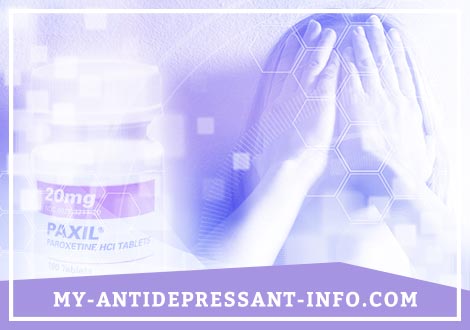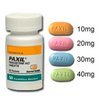
Mental abnormalities are often disguised as disorders of the internal organs. For example, generalized anxiety disorder can cause high blood pressure, tachycardia, dizziness, headache, muscle tension, sweating, and fatigue. In most cases, these symptoms signal diseases of the cardiovascular system or thyroid gland. Only an attentive doctor will take an interest in the patient's emotional state and make the correct diagnosis.
Mental disorders are also difficult to detect due to patients' neglect of their health. In the early stages, depression, PTSD, and obsessive-compulsive disorder (OCD) are not severely uncomfortable. Patients usually see a doctor several months or even years after the first symptoms appear. At this stage, traditional methods of psychotherapy have little effect, and the use of drugs is required.

Paxil (Paroxetine) is a reliable antidepressant that is used to combat common behavioral disorders. It is prescribed for OCD, generalized anxiety disorder, panic attacks, various types of depression, post-traumatic stress disorder, and social phobias. It is allowed to take pills for less serious mental problems, in particular nightmares.
Women should order Paxil for severe premenstrual dysphoric disorder. The antidepressant suppresses the symptoms of the disease and has a positive effect on the mental state. In small doses, the medicine helps to overcome the vasomotor symptoms of menopause: hot flashes, night sweats, heart palpitations, and others.
What is Paxil?
In 1992, the FDA approved the medical use of the antidepressant paroxetine, which has changed the lives of millions of people with mental disorders. The patent for the invention belongs to the British pharmaceutical company GlaxoSmithKline. The medication is sold under the Paxil brand.
Immediately after its appearance in pharmacies, the drug began to be in great demand. More than 8 million Paxil tablet prescriptions are issued annually in the United States alone. Paroxetine is one of the top 15 most prescribed antidepressants in the world.
Initially, pharmacists underestimated the range of uses of the drug. After the start of sales, additional studies were conducted that showed the high efficacy of the drug in panic disorder. In addition, in 2013, it began to be used to suppress the symptoms of menopause.
Paroxetine belongs to the group of selective serotonin reuptake inhibitors. It is the most popular class of antidepressant drugs used in modern psychiatry. Distinctive features of the drug - the effectiveness and minimal risk of recurrence of the disease, combined with a relatively low probability of side effects.
How does Paroxetine work?
The reasons for the development of depression are still a mystery to scientists. The most popular theory is related to impaired production or perception of serotonin. Paroxetine helps to deal with this problem. An antidepressant traps neurotransmitter molecules in the space between nerve cells, enhancing its effect. The effect of the drug on the content of other biologically active substances in the brain is insignificant.
The active substance quickly reduces anxiety and improves sleep. Therefore, patients suffering from phobias and anxiety attacks are advised to buy Paxil in the first place. Other medicines are prescribed only for serious contraindications or intolerance to Paroxetine.
The structure of Paxil differs from other antidepressants, which gives it a number of advantages:
- much less likely to cause side effects from the gastrointestinal tract;
- does not depress the central nervous system;
- does not affect the cardiovascular system and does not cause a decrease in blood pressure.
A stable concentration of Paroxetine in the body is observed 7-14 days after the start of therapy. Further administration of the drug does not lead to an increase in the level of the active substance.
In what doses is Paxil taken?
The medicine must be taken orally once a day. Swallow your Paxil tablet whole without chewing or otherwise crushing. The best time to take is in the morning with meals.
The doctor selects the treatment program individually, based on the type and severity of the disorder, as well as the patient's state of health. Most often, the drug is prescribed in the following doses:
- Panic disorder. Therapy starts with 10 mg per day, and every week the dose is increased by 10 mg. The optimal amount of medication is 40 mg per day.
- Depression. Take 20 mg daily. If symptoms do not improve, the dosage is increased by 10 mg every week until the condition improves.
- Obsessive-compulsive disorder. In the first week, take 20 mg of Paroxetine, in the second - 30 mg, in the third and subsequent - 40 mg.
- Phobias and anxiety disorders. The standard dose is 20 mg, but this can be increased if necessary.
- Premenstrual dysphoric disorder and menopause. Take 12.5 mg - 25 mg every 24 hours.
Correction of therapy should take place under the supervision of a physician. For most mental illnesses, the maximum daily dose of Paroxetine is 50 mg. However, if the disorder continues to progress, it is allowed to take up to 75 mg of the medication per day.
Patients with severe renal and hepatic impairment should take Paxil at a reduced dosage. In old age, correction of treatment is usually not required.
An overdose of Paroxetine significantly increases the risk of side effects. Muscle contractions, fever, tachycardia are also possible. When taking a large number of tablets in a short period of time, gastric lavage and activated charcoal are prescribed. If you do not combine Paxil with other psychotropic drugs and alcohol, overdose usually does not lead to serious consequences.

Paroxetine side effects
The low likelihood of side effects is one of the most compelling reasons to order Paxil. Of the 8,000 volunteers who participated in antidepressant clinical trials, less than 25% experienced discomfort. Most often, patients complained of:
- decreased appetite, nausea, constipation, diarrhea, dry mouth;
- drowsiness or insomnia;
- yawning;
- tremor;
- temporary decrease in vision clarity;
- sweating;
- rapid fatigue after physical exertion (asthenia);
- dizziness, headache;
- sexual dysfunction;
- rhinitis, sinusitis.
People under the age of 25 may have suicidal ideation while taking Paxil. If you notice mood changes or depression, see your doctor. In a more mature age, such violations occur extremely rarely.
Paroxetine side effects are most commonly seen in the first weeks of treatment. After the organism gets used to the drug, these disorders usually disappear. If you experience severe discomfort and other negative reactions, consult your doctor.
Withdrawal syndrome
You cannot abruptly stop taking Paxil tablets due to the risk of withdrawal symptoms. The dosage of the medication must be reduced weekly by 10 mg. When you reach the 20 mg dose, continue taking the drug for another week and then stop. This schedule may be changed if severe withdrawal occurs.
If you do not taper the dosage gradually, you may experience side effects of Paroxetine. Withdrawal from the medication is accompanied by sleep disturbance, dizziness, tremors, nausea, confusion, sweating and headache. Symptoms disappear in 1-2 weeks, but in rare cases they bother up to 3 months. Withdrawal symptoms sometimes appear when 2 or more doses are missed. To avoid deterioration of well-being, follow the schedule of taking the drug.
Buy Paxil is necessary for patients who are afraid of drug addiction. Studies of the drug have shown that the risk of addiction to the drug tends to zero. Having withdrawal symptoms does not mean that you have abused or become dependent on the antidepressant.
Paxil Compatibility with Other Medicines
Paroxetine should be combined with caution with other antidepressants. The combination of psychotropic drugs leads to an increase in their effect. Such combinations of medicines are used for severe depression only with the permission of a doctor.
Concomitant use of Paxil with serotonergic drugs and opioid analgesics can lead to the development of serotonin syndrome, a health hazardous condition caused by increased levels of a neurotransmitter. If such a combination is necessary, the physician should monitor the clinical picture.
Paroxetine is not prescribed with the following medicines:
- monoamine oxidase inhibitors;
- tryptophan;
- warfarin;
- some antidepressants (bupropion, imipramine, desipramine, trazodone).
The psychotropic drug interacts with anticoagulants, increasing the risk of bleeding. Sodium valproate, beta-blockers and cimetidine enhance the effect of Paroxetine, while barbiturates, on the contrary, weaken its effect. When combining these drugs, a dosage change is required.
Be sure to tell your doctor about any medications you are taking before purchasing Paxil. Combining an antidepressant with certain medications can seriously harm your health.
It is not safe to combine depression medication with alcohol. Refrain from drinking alcohol while Paroxetine is active and for several days after treatment ends.
Taking Paxil during pregnancy and breastfeeding
The use of the drug in the first trimester of pregnancy doubles the risk of a defect in the cardiovascular system in a newborn. Paroxetine can cause atrial and ventricular septal abnormalities in an infant. In addition, the effect of the antidepressant is associated with lower body weight in the child.
When taking Paxil tablets in the third trimester of pregnancy, there is a small chance of tremors, tremors, apnea, cyanosis, drowsiness, hypotension and other complications in the baby. Therefore, the drug is prescribed only if the mental illness poses a direct threat to the life or health of the woman. In other situations, doctors are limited to safer therapies.
Minimum doses of Paroxetine pass into breast milk. Women who need an antidepressant should transfer the infant to formula feeding.
Antidepressant use in pediatrics
Paxil has shown low efficacy in treating depression in minors. When Paroxetine works, about 2% of patients 12-17 years old have suicidal ideation. Despite this, some experts admit the use of the drug in pediatrics for obsessive-compulsive disorder and social phobia. Taking an antidepressant must be approved by a doctor.
Treatment of premenstrual dysphoric disorder and menopausal syndrome.
Abdominal pain, mood swings, irritability, breast tenderness are typical symptoms of premenstrual syndrome. According to various estimates, from 4% to 7% of women experience premenstrual dysphoric disorder, which is accompanied by:
- depression;
- a feeling of deep despair;
- cramps, muscle spasms;
- forgetfulness;
- impaired concentration, low reaction rate;
- overeating, pain in the joints;
- skin rash, exacerbation of eczema;
- anxiety, bouts of aggression and other symptoms.
Scientists suggest that the reason for the deterioration in well-being lies in the susceptibility to hormones. The body can react negatively to an increase in progesterone after ovulation. This condition lasts from 3 days to 2 weeks.
One way to combat premenstrual dysphoric disorder is with combined oral contraceptives. They prevent ovulation and stabilize hormone levels. But contraception is not suitable for all women and does not always work.
A more efficient method is to order Paxil. The drug reduces the sensitivity of the receptors of the nervous system and relieves most of the symptoms. Also, the drug is effective in severe menopausal syndrome. An antidepressant eases the transition period, prevents the onset of vasomotor symptoms, and improves mood.
Paroxetine for premenstrual dysphoric disorder and during menopause
The usual dosage of Paxil for premenstrual dysphoric disorder is 12.5 mg. The drug can be taken throughout the entire monthly cycle or within 2 weeks after ovulation. The course of treatment must be repeated every month. If the state of health does not improve, the daily dose is increased to 25 mg.
The same Paroxetine regimen is used during menopause. The drug is taken constantly. A woman using an antidepressant should be examined by a doctor every few months.
You can enhance the effect of the drug by adhering to a healthy lifestyle:
- increase physical activity (walking more, cycling, climbing stairs);
- sign up for yoga, aerobics or fitness;
- balance nutrition, increase the amount of vegetables in the diet, give up foods rich in simple carbohydrates;
- avoid stress;
- give up bad habits.
Even in the smallest doses, Paroxetine is only taken with a doctor's permission. The specialist will be able to assess the potential risks and benefits of using the drug. To avoid side effects and not harm health, it is better to coordinate the dosage and schedule of taking the drug with a doctor.
With Paxil tablets, you stop worrying about the end of your menstrual cycle. The drug ensures good health and mood in a difficult period for every woman. It also prevents the negative effects of hormonal changes in the body during menopause.
 DE
DE FR
FR IT
IT ES
ES





